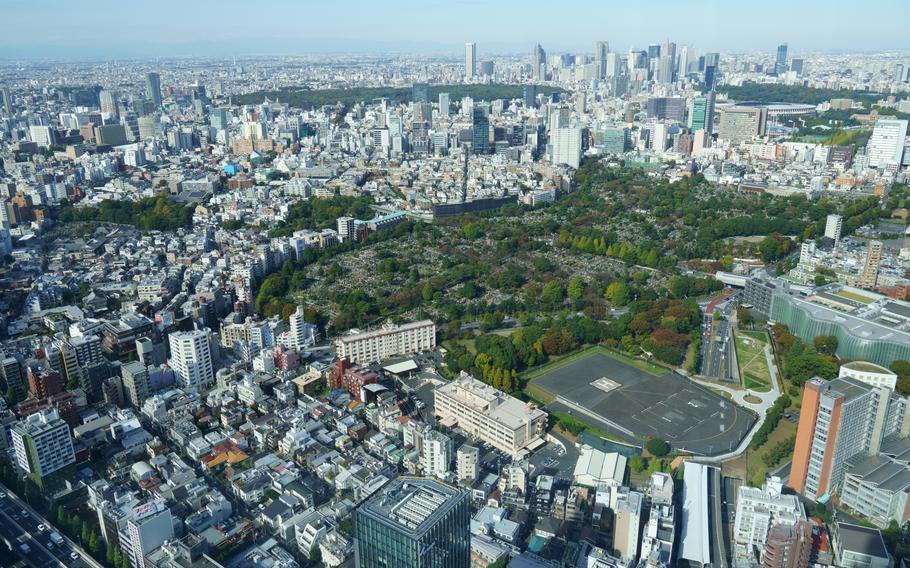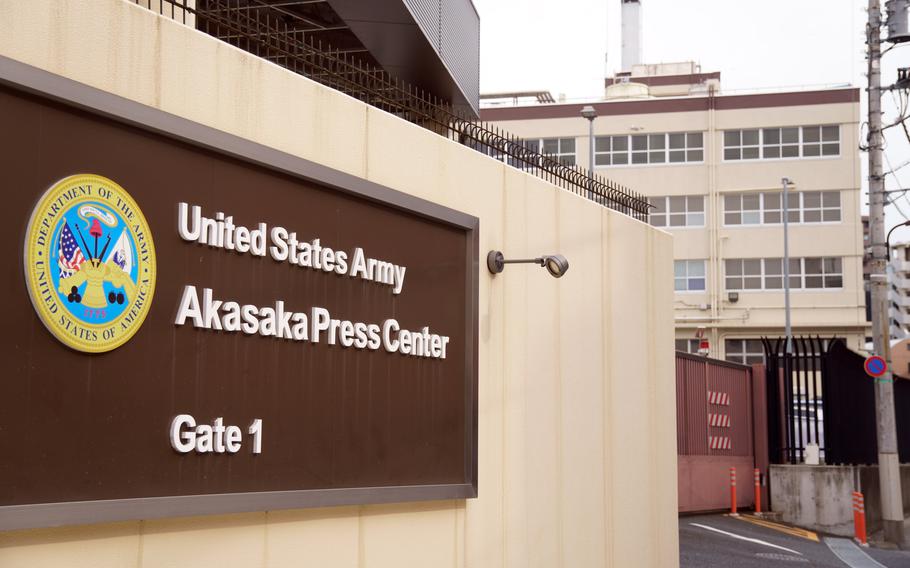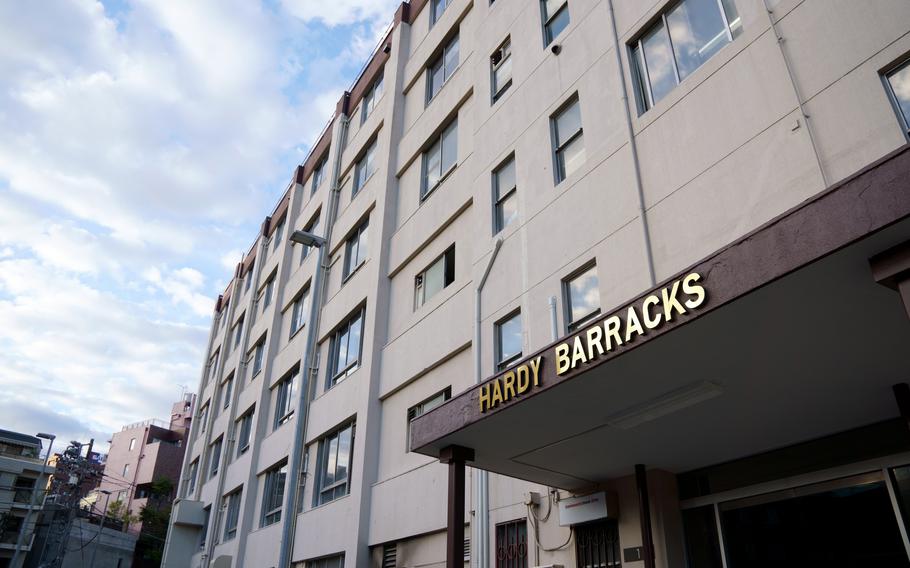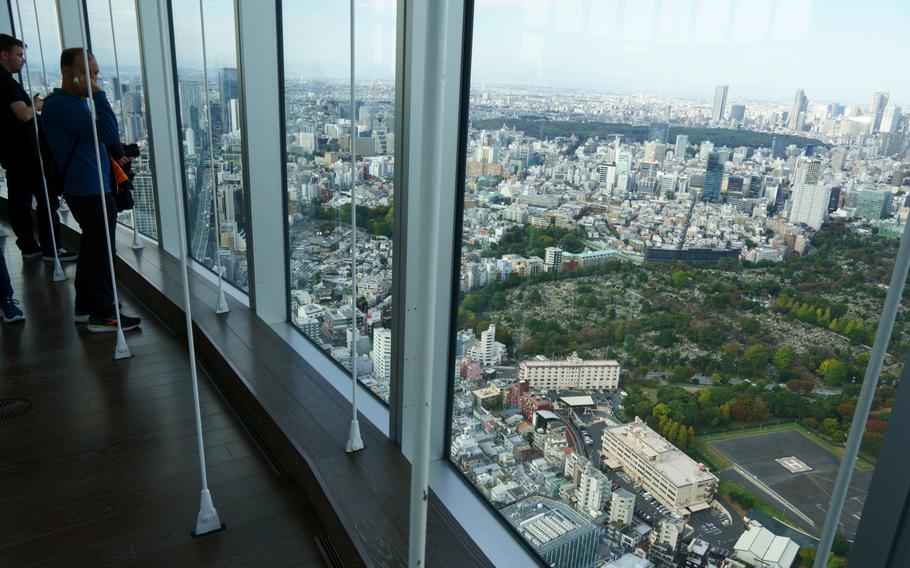
The Akasaka Press Center, Hardy Barracks and a U.S. Army helipad are seen from the Roppongi Hills Mori Tower observation deck in Tokyo on Nov. 8, 2024. (Akifumi Ishikawa/Stars and Stripes)
TOKYO — U.S. Forces Japan may appropriate a central Tokyo compound that includes the headquarters of Stars and Stripes Pacific as the command weighs a move from the city’s western suburbs, the newspaper has learned.
USFJ is restructuring into a joint force headquarters, a plan announced by the Pentagon in July to build a closer relationship with the Japan Self-Defense Forces.
Relocating some of its functions from Yokota Air Base in western Tokyo to the busy Roppongi district in the city center would put USFJ within 2½ miles of Japan’s Ministry of Defense in Ichigaya.
As part of that anticipated move, USFJ and U.S. Army Garrison Japan, which administers the Akasaka Press Center, are surveying the site to see if it meets their needs, according to multiple sources within USFJ who are not authorized to speak to the media.
The press-center compound — commonly called Hardy Barracks after an onsite Morale, Welfare and Recreation lodging facility — houses several tenant commands, including the Office of Naval Research, and has been the home of Stars and Stripes Pacific since 1952. The curvy roadway out front, Seijoki Dori — Stars and Stripes Street — is named for the paper.

The Akasaka Press Center has been home to Stars and Stripes Pacific since 1952. (Akifumi Ishikawa/Stars and Stripes)
A USFJ spokesman, Air Force Capt. Danny Rangel, would not confirm or deny whether the press center was under consideration and said USFJ is in the “early stages of determining the specific resources and facilities necessary” to accommodate its transition.
“In support of USFJ’s transformation into a Joint Forces Headquarters, change is necessary to meet the evolving challenges within the Indo-Pacific region and to effectively stand shoulder-to-shoulder with our Japanese partners,” he told Stars and Stripes by email Nov. 6.
The command oversees about 115,000 troops, civilians and family members in Japan.
Japan’s Defense Ministry expects that details on USFJ’s restructuring will “be discussed in a Japan-U.S. working group,” but “nothing has been decided at this point, including a specific location,” a ministry spokesperson told Stars and Stripes by email Friday.
Government spokespeople in Japan typically speak to the media on condition of anonymity.

Hardy Barracks is a U.S. Army Morale, Welfare and Recreation lodging facility on the grounds of Akasaka Press Center in the heart of Tokyo's Roppongi district. (Akifumi Ishikawa/Stars and Strip)
Air Force Lt. Col. Marci Hoffman, commander of Stars and Stripes Pacific, said she asked USFJ by email Tuesday for information about the command’s interest in the press center but had not received a response that morning. She referred further questions to USFJ.
The garrison referred questions to U.S. Army Japan, which also referred Stars and Stripes to USFJ.
Rangel said the command is in the “early stages of discussions” and “committed to ensuring thorough and deliberate coordination among our various stakeholders.”
The Tokyo Metropolitan Government is unaware of any plans to move USFJ assets to central Tokyo, a base affairs spokesman told Stars and Stripes by phone Nov. 5. He said the metro government has regularly asked that Akasaka Press Center be returned to the city.
Reorganizing USFJ is part of the Defense Department’s response to growing threats in the region from China, Russia and North Korea. Defense Secretary Lloyd Austin in July described the restructuring as the “most significant change” to USFJ since it was created.
The Pentagon plans to modernize USFJ into a command with “expanded missions and operational responsibilities” that would serve as a counterpart to Japan’s recently created Japan Self-Defense Forces Joint Operations Command.

The Akasaka Press Center, Hardy Barracks and a U.S. Army helipad are seen from the Roppongi Hills Mori Tower observation deck in Tokyo on Nov. 8, 2024. (Akifumi Ishikawa/Stars and Stripes)
How much of USFJ’s functions, if any, would relocate to the gated compound in Roppongi, a business and entertainment district known for its nightlife, is unclear.
The property includes a helipad, a center city transit point for visiting U.S. politicians, including presidents, high-ranking military officers and foreign dignitaries.
Local media often take issue with low-level flights over the city and the helipad operations. The Mainichi newspaper in July 2022 quoted the Japan Defense Ministry defending U.S. overflights as “imperative” and “crucial” to its role of defending Japan.
Moving USFJ out of Tokyo’s western suburbs contrasts with Pentagon decisions to relocate other U.S. military installations farther from urban centers, said Robert Eldridge, a senior fellow at The Japan Institute of International Affairs in Tokyo.
U.S. Forces Korea exited Yongsan Garrison in central Seoul starting in 2018 for Camp Humphreys, a sprawling, $10.7 billion U.S. Army base in Pyeongtaek about 40 miles to the south, he said by phone Thursday.
Relocating USFJ headquarters would represent a “clear indication about how worried Japan is” about threats from China, North Korea and Russia, according to Grant Newsham, a retired Marine colonel and senior fellow with the Center for Security Policy.
“Now that there are such threats to Japan the Japanese are scrambling to improve their military and national defense — and also pushing the Americans to stay committed to defending Japan,” he said by email Thursday.